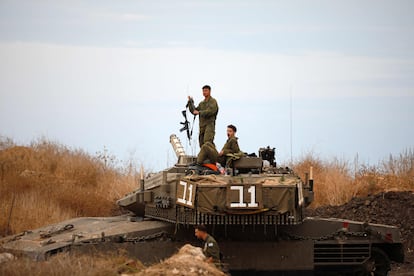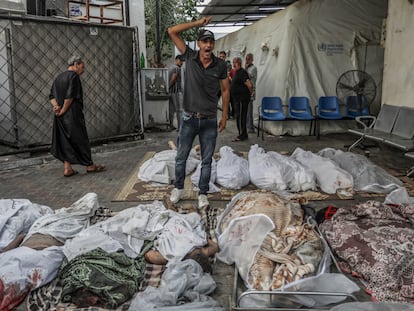Gaza, a slow and secretive invasion
Analysts believe that Israel’s strategy avoids troop casualties, provides time for possible hostage negotiations and gives it the option of carrying out several long raids, instead of one definitive operation

Last Friday, after announcing an invasion to “destroy Hamas” that could last months or even years, Israeli troops and armored vehicles entered Gaza amid unprecedented heavy and intense bombings that have killed hundreds of Palestinians. The following morning, Richard Hecht, the international spokesperson of the Israel Defense Forces (IDF), told reporters by videoconference that it was more of a “targeted raid.” Hours later, Israeli Defense Minister Yoav Gallant said that the move marked a “new phase” of the war against Hamas, and that troops would remain in Gaza “until further notice.”
Since then, Israel has been carrying out the invasion with an aura of secrecy, aware that its military interests — the surprise effect, building uncertainty — go against what the press and public are calling for — access, transparency and clear messages. While the Israeli army makes vague announcements and censors the information of local military correspondents, its troops are slowly advancing along the tiny Gaza strip. Staging a lightning offensive is incompatible with the negotiations to free the more than 200 hostages, the logistical preparation for a “long war” — as Israeli Prime Minister Benjamin Netanyahu defined it — and the waiting period for U.S. aid to arrive, in case the war against Hamas triggers a regional conflict.
The “great invasion” of Gaza, which Israel has been announcing for the past two weeks, may not be exactly what is expected. “The current operation is significant, but perhaps not as large as anticipated. The strategy may consist of carrying out several similar operations over time, not a definitive one. Many people were expecting some sort of pre-announced assault, but that’s not how things work,” says Chuck Freilich, former deputy national security advisor to the Israeli government, professor at Columbia University in the United States and Tel Aviv University, and author of three essays on Israel’s security, over the phone.
Eitan Shamir, director of the Begin-Sadat Center for Strategic Studies at Bar Ilan University and an expert in military strategy and command, thought Israel would go for a “quick and deep” invasion to cut off the various parts of the Strip, in line with classic military strategy. However, he is seeing a “slow and phased” advance. This strategy lowers the risk of Israeli troop casualties and “allows time for the possibility of reaching an agreement with Hamas for the release of the hostages.” “It consists of going little by little, going over every area well,” says Shamir, pointing out that at this pace, it will take months for the operation to be completed.
Yoav Zitun, military affairs correspondent for the newspaper Yediot Aharonot, said Monday that, “if the army continues to advance at its current pace, completing the operation could take between six and 12 months,” compared to the “initial estimates that the war would involve two to three months of fighting.”
At the moment, it is not known how many soldiers are deployed, nor where they are in Gaza. It’s also not known which units they’re from or what means they have available. What is known is that the troops have remained inside Gaza since Friday, that the ground deployment has been growing, and that it is supported by heavy air and naval fire — the likes of which have not been seen in decades. According to the Gaza Health Ministry, more than 8,300 Palestinians have died in the strikes, mostly women and children. The Israeli army has shared short, edited videos of the advance of armored vehicles, moving through what appears to be agricultural, coastal or abandoned areas.
The well-protected troops appear to be looking for traps set by Hamas militants, who know the terrain. They are also familiar with the tunnel system and have information about the hostages. On Monday, the Israeli army announced the first rescue of a hostage, the captive soldier Colonel Uri Magidish.
Urban warfare
The fact that the tanks are already at the gates of Gaza City does not mean the advance was quick, given the dimensions of the Strip. The northern part of Gaza — and especially the center — are so narrow that barely a mile separates the eastern border from the first streets of the capital. In images released by the army on Saturday, a line of armored vehicles could be seen moving north to south down a beach on the Mediterranean Sea. But just two to three miles away are scenes of urban warfare. Some experts estimate that Israeli forces are advancing just 100 meters a day.
Israel’s key objective is the capital, Gaza City. To reach it, it is advancing from the north with bulldozers, mowing down large parts of territory and destroying the buildings left standing after the aerial bombardments. Especially in the area where airstrikes have wiped out entire city blocks, as seen in aerial images.
“It has not been a lightning response, like other times. It’s cautious,” Freilich points out. One of the reasons, he stresses, is that Israel was “very unprepared” to launch an invasion of Gaza, a territory that it lacks intelligence on and which is controlled by Hamas, whose military capabilities “it had grossly underestimated.” It had no choice, he adds, but to wait and spend time training the more than 300,000 reservists who have been mobilized, assembling a powerful force and waiting for the U.S. deployment to arrive to cover its back.
In the meantime, Israel is bombing heavily from the air, which allows it to cause great destruction with little risk of suffering casualties. “When our forces arrived, some of the enemy were already wounded, some dead and some unable to operate [due to the bombings]. Some have fled, others are still there and our forces are fighting them,” said Chief of Staff Herzi Halevi.
The bombardments on Sunday reached the “deepest point in Palestinian territory since the war began,” an unidentified military commander told the daily Maariv. A video of a soldier placing an Israeli flag on the roof of a Gaza hotel, which has been geolocated about two miles from the border, was seen on social media. A voice is heard identifying the battalion and noting that it is “on the beach” and “in the heart” of Gaza “three weeks after” the attack, in which Hamas and Islamic Jihad killed around 1,400 people, mostly civilians. “We will not forgive, we will not forget, and we will not stop until we are victorious,” the voice is heard saying.
Propaganda videos, released by the militias, are also circulating, showing direct hits by shells on armored vehicles. The Israeli army has not, however, reported a single soldier killed (only wounded) since Friday, although there have been no direct clashes. In the current type of combat, there tend to be few Israeli troop casualties, due to the fact the Israeli army greatly outpowers the militants. “We have not encountered strong resistance so far. They have only been firing at us from a distance and afraid to charge at the troops. They are facing a huge curtain of fire,” another soldier told Maariv, referring to the “massive use of firepower on a scale not seen since the Yom Kippur War” 50 years ago. The Israeli army did account for targeted assassinations of minor Hamas leaders and the “neutralization of dozens of terrorists.”
Shamir does not believe that a months-long offensive will affect the international support for Israel due to the scale of the October 7 Hamas attack and the images of the assassinations. “As long as humanitarian aid continues to enter [the south], as requested by the United States, and there is no humanitarian crisis with people going hungry, there will be demonstrations, yes, but I don’t think the governments of the world will stop it. And even if they try, the key is the United States.”
Last Thursday, just before the invasion, one of the country’s most influential journalists, Ilana Dayan, was interviewing Barak Hiram, the commander of a division (99) with infantry, armor, artillery and special forces. Created in 2020, it trains in reconstructions of Arab villages and towns, with Palestinian flags and images of Hezbollah leader Hasan Nasrala. Dayan concluded by asking where he saw himself in a week’s time:
- I hope deep inside [Gaza].
- And a year from now?
- Maybe still deep inside.
Sign up for our weekly newsletter to get more English-language news coverage from EL PAÍS USA Edition
Tu suscripción se está usando en otro dispositivo
¿Quieres añadir otro usuario a tu suscripción?
Si continúas leyendo en este dispositivo, no se podrá leer en el otro.
FlechaTu suscripción se está usando en otro dispositivo y solo puedes acceder a EL PAÍS desde un dispositivo a la vez.
Si quieres compartir tu cuenta, cambia tu suscripción a la modalidad Premium, así podrás añadir otro usuario. Cada uno accederá con su propia cuenta de email, lo que os permitirá personalizar vuestra experiencia en EL PAÍS.
¿Tienes una suscripción de empresa? Accede aquí para contratar más cuentas.
En el caso de no saber quién está usando tu cuenta, te recomendamos cambiar tu contraseña aquí.
Si decides continuar compartiendo tu cuenta, este mensaje se mostrará en tu dispositivo y en el de la otra persona que está usando tu cuenta de forma indefinida, afectando a tu experiencia de lectura. Puedes consultar aquí los términos y condiciones de la suscripción digital.
More information
Archived In
Últimas noticias
The complicated life of Francesca Albanese: A rising figure in Italy but barred from every bank by Trump’s sanctions
How Japan is trying to avert ‘digital defeat’
Half of Scotland is in the hands of 420 property owners
Reinhard Genzel, Nobel laureate in physics: ‘One-minute videos will never give you the truth’
Most viewed
- Pablo Escobar’s hippos: A serious environmental problem, 40 years on
- Why we lost the habit of sleeping in two segments and how that changed our sense of time
- Charles Dubouloz, mountaineering star, retires at 36 with a farewell tour inspired by Walter Bonatti
- Reinhard Genzel, Nobel laureate in physics: ‘One-minute videos will never give you the truth’
- The Florida Keys tourist paradise is besieged by immigration agents: ‘We’ve never seen anything like this’











































